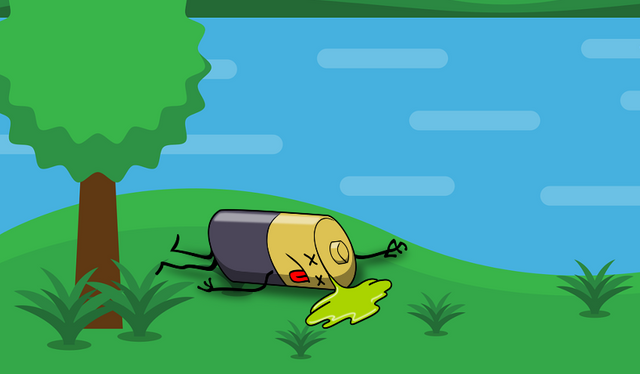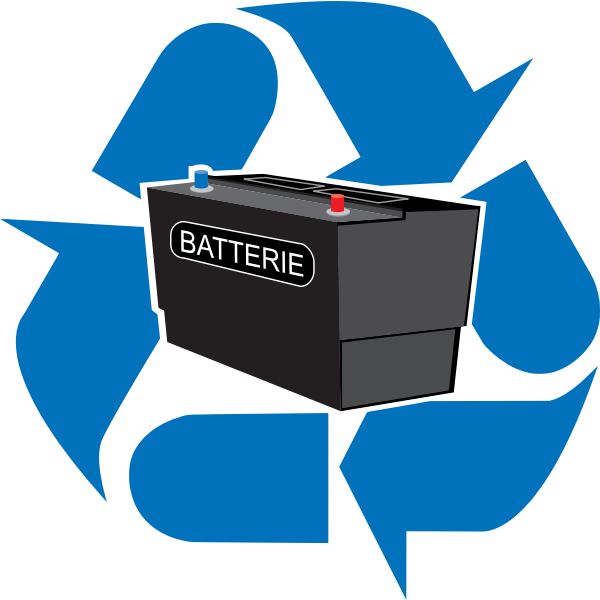Environmental impact of batteries
Batteries are one of the essential elements for the functioning of our modern technology, enabling the operation of watches, flashlights, toys, radios, telephones, medical sensors and a large number of electronic devices. Perhaps you are aware, or perhaps not, of the amount of metals and hazardous substances contained in a single battery, and of the danger posed to the environment and our health by the mismanagement of spent batteries, which is why we must make a rational use of them, since at the end of their useful life they are capable of releasing these substances into the environment.

A single battery can contaminate a large amount of water. Source: edited image, landscape and dead battery are in the public domain.
And why are batteries so harmful?
Cells and batteries are elements that provide energy, converting the chemical energy released by chemical reactions into usable electrical energy, for example, in a common battery energy is obtained during the reaction between zinc and manganese dioxide, which are in contact with each other by means of an ammonium chloride gel. The problem with common batteries is that the zinc, from which the battery container is made, leaks the corrosive components inside, so we should not leave batteries in electronic devices.
However, alkaline batteries work in a similar way to regular batteries, except that they use potassium hydroxide as the electrolyte, an alkaline substance.

Spent batteries leak hazardous substances. Source: Wikimedia.org.
Button cells, those small batteries commonly used in watches and hearing aids, can be made of different substances, including mercury oxide, silver oxide, zinc and lithium. Initially, these batteries were made with mercury oxide, which during the discharge of the battery converts into metallic mercury, which can easily react to become methyl mercury, a toxic compound easily assimilated by living beings.
And lead-acid batteries, those used in conventional vehicles, are composed of a lead anode and a lead dioxide cathode, and both electrodes are immersed in concentrated sulfuric acid; although it was one of the first rechargeable batteries to be used commercially, its waste must be properly managed as it contains very hazardous substances.
Another of the most widely used rechargeable batteries are lithium-ion batteries, which have been widely used since their commercialization began in the early 90's. This is the most widely used battery in cell phones, tablets, laptops, electric vehicles, among others. This type of battery generally consists of a lithium cobalt oxide cathode (LiCoO2) and more recently of lithium iron phosphate (LiFePO4).
As we can see, the most commonly used batteries contain around 30% of heavy metals, such as lead, mercury, cadmium and lithium, among others, as well as highly corrosive acidic or alkaline substances, making them truly harmful to the environment and to living beings. And as incredible as it may seem, a single button cell battery could contaminate more than 300,000 L of water, and it is estimated that inadequate management of batteries is responsible for 93% of mercury in household waste, 47% of zinc and 48% of cadmium, among other metals.

Leaking button cell battery. Source: Wikimedia.org.
What can we do to control battery pollution?
Use rechargeable batteries. Although they are also polluting, rechargeable batteries have a longer life cycle than regular batteries, so we can avoid disposing of a large number of regular batteries. And when choosing rechargeable batteries, try to use nickel-metal hydride batteries rather than nickel-cadmium ones.
If we need to use button cell batteries, we should choose those that do not contain mercury.
Try not to throw batteries in the household garbage, as they will end up in a landfill or be incinerated, releasing their polluting compounds. If there is no battery recycling program in our region, then we should try not to pile them up, since disposing of a large number of batteries poses a greater risk than if they are scattered among the waste.

We should try to recycle batteries. Source: freesvg.org.
Above all, it is essential to promote the culture of recycling, to deposit used batteries in appropriate places for their collection and final disposal, although it is true that in many countries there are no recycling programs for batteries, so we must at least avoid that they do not end up in a water source, since a single battery could contaminate a volume of water equivalent to an Olympic swimming pool.
Thanks for coming by to read friends, I hope you liked the information. See you next time.

References
UNICEN. Pilas y baterías: cómo minimizar el impacto ambiental
Fascienciate.com. Todo funciona con pilas. Y, ¿Cómo funcionan las pilas?.
I once heard a story of a young lady who used her hand to remove a spoilt battery and she eat with the same hand without washing it, she ended up on a hospital bed. Contact with batteries could cause damage for the body and even for the society like you have mentioned correctly, proper recycling is very important.
It is unfortunate what happened to the young woman, there are many cases like this, because many people are unaware of the dangers that batteries hide, recycling and final disposal is very important, and the authorities should promote the necessary mechanisms for it.
Thank you very much for your support!